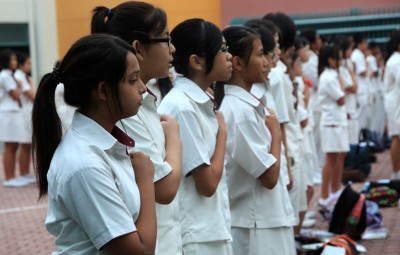Singapore has one of the best education systems in the world, according to international assessments. President Barack Obama and Secretary of Education Arne Duncan talk about its performance. United Federation of Teachers President Randi Weingarten visited in 2012 and her counterpart at the National Education Association, Dennis Van Roekel, has praised its teacher training. And in 2012, Singapore was featured in the first-ever International Summit on the Teaching Profession as a country that many places – including America – could learn from.
In light of all this hype, I spent the past week in Singapore visiting schools to find out why they are so successful. But, not surprisingly, there’s no big secret or magic trick that the United States could simply copy tomorrow. Rather, my impressions were of a nation where education is respected, where educators and administrators think critically about their jobs and the qualities they want their students to develop and where self-reflection is ingrained. Those are qualities already found in many American schools, and that reformers are trying to spur in others.
But some of Singapore’s latest strategies go beyond or challenge some of the most popular ideas right now for improving American schools. At the same time, it’s important to remember the vast differences between the two countries that make it difficult to transfer ideas. Here are my main takeaways from my conversations with educators, students and education officials:
– Singapore is looking to revamp their standards. As most states in America continue the rollout of the Common Core State Standards, an internationally benchmarked guide laying out what students are supposed to learn in each grade in math and English, Singapore also has changes planned. But education officials there are more concerned about some less tangible skills, like collaboration and creativity, and coming up with ways to systematically introduce those into the curriculum. In theory, the end goals of Common Core and Singapore’s newest push are similar. They both aim to create individuals with critical thinking skills who can thrive in a modern economy. But as we try to copy Singapore’s methods, like their math sequencing, educators there are already moving on to new ideas.
– Lots of Singaporean students are stressed. The country is looking for ways to reduce this and trying to decrease the emphasis on grades and test scores. The Ministry of Education is trying to reduce the emphasis on the primary school exit exam, which all students have to take to determine which secondary school they will attend, for instance. But many people told me one of the biggest challenges will be changing the mindset of parents. Not all students in Singapore worry endlessly about exams, but several people said that for those that do, parents are a primary source of their anxiety.
– Singapore is small. As several people pointed out to me, if you drive for an hour in any direction, you arrive at the water. While some people told me the small size of the country has disadvantages for education – it severely limits options for field trips for instance – it also has its benefits. Most notably, the country’s size, along with the fact that the schools are run by a centralized authority, allows the Ministry of Education, the National Institute of Education – which trains every teacher in the country – and the schools to be in close communication about research and new strategies. New programs can be implemented quicker and the National Institute for Education can easily keep track of what is actually happening in classrooms to tweak its offerings when needed.
– The schools are big. Half a million students are enrolled in the island’s schools, but most schools have student populations of more than a thousand – even at the primary level. With that many students, classes of 35 to 40 are typical, but nothing seemed disorderly. The atmosphere in the classrooms that I visited switched between formal and relaxed. Students bowed to greet visitors and again to thank them for coming. They stood up to speak whenever called upon, and chatter while a teacher was talking was almost nonexistent. At the same time, though, laughter was common. Teachers would gently tease students and discussion was highly encouraged.
Not everything Singapore does would apply to our much larger, decentralized education system and not everything they do should be emulated. But there are some inspirations we could draw from the country, such as trying to get more high-performing students into the classroom as teachers or being more explicit in the character qualities we want students to develop – without obsessing over how to measure them.




